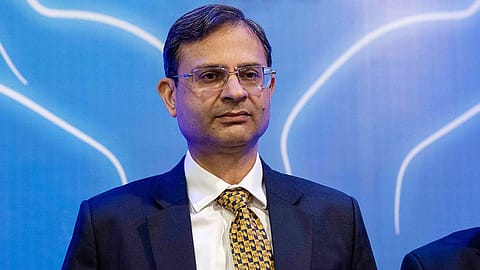India’s lower dependence on exports cushions economy from external spillovers: RBI governor
At a time when many advanced economies are facing economic headwinds and a deteriorating economic outlook, India continues to offer strong growth and stability, says RBI governor Sanjay Malhotra.

India’s strong domestic demand and relatively lower dependence on exports cushions the Indian economy from external spillovers, according to Reserve Bank of India governor Sanjay Malhotra.
“At a time when many advanced economies are facing economic headwinds and a deteriorating economic outlook, India continues to offer strong growth and stability, making it a natural choice for investors seeking long-term value and opportunity,” Malhotra said in his keynote address at the US-India Economic Forum.
The RBI governor said India continues to be an economy supported by stability – monetary, financial and political; policy consistency and certainty; congenial business environment; and strong macroeconomic fundamentals.
“Over the last ten years, we have leapfrogged from the tenth largest economy to the fifth. In terms of purchasing power parity, we are already third. Even nominally, we are poised to become the third largest economy shortly. We aspire to become Viksit Bharat, i.e., a developed economy by 2047, when we complete 100 years of our independence. While there is indeed a scope for India’s growth trajectory to rise over the medium to long-term, I am sanguine of our continued success. There are a lot of positive factors that give me this confidence,” the RBI governor said.
Malhotra said almost all sectors have been opened up to 100% foreign direct investment (FDI). “Almost 90% of the FDI is now under the automatic route. In the recent years, we have introduced a series of liberalisation measures to further open up the economy, particularly in key sectors such as Defence, Insurance, Petroleum & Natural Gas, Telecom, and Space,” he said.
The RBI chief said India’s banking sector, which continues to meet the large funding requirements of the economy, has demonstrated resilience with healthy balance sheet. “The soundness of scheduled commercial banks (SCBs) has been bolstered by strong profitability, lower non-performing assets and adequate capital and liquidity buffers,” said Malhotra.
“The health of the nonbanking financial companies (NBFCs) sector is also robust. Bank credit growth although moderating in recent months, continues to be in double digits (about 12%) compared to an average of about 10.5% in the last 10 years. We are committed to further enhancing the capacity, responsiveness, and resilience of the banking and non-banking financial sectors with emphasis on balancing regulation with efficiency and stability,” he added.
Recommended Stories
India’s capital markets have witnessed record participation from retail and institutional investors, said the RBI governor. “There are almost 106 million unique demat accounts and more than 54 million unique mutual fund accounts. The stock market has delivered returns at a staggering 11% CAGR over the last twenty years. With more than 500 listed companies having a market capitalisation of more than $1 billion each the capital market offers enormous opportunities to participate in India’s growth story. Indian financial markets offer seamless entry and exit for foreign investors, reflecting the maturity of its economy,” said Malhotra.
On the foreign exchange market, Malhotra said it has the required depth and liquidity to weather pressures, such as seen in the last few months. “India’s current account deficit (1.3% of GDP during April-December 2024) remains eminently within manageable limits, supported by robust services exports and private remittances. Even in the recent volatile period, the Indian rupee (INR) has moved in an orderly manner and performed relatively better compared to its peers, reflecting strong macroeconomic fundamentals, adequate foreign exchange buffers and depth of our foreign exchange market,” explained Malhotra.
“India’s current account deficit (1.3% of GDP during April-December 2024) remains eminently within manageable limits, supported by robust services exports and private remittances. Even in the recent volatile period, the Indian rupee (INR) has moved in an orderly manner and performed relatively better compared to its peers, reflecting strong macroeconomic fundamentals, adequate foreign exchange buffers and depth of our foreign exchange market.
Gross foreign direct investment (FDI) inflows to India increased to $75.1 billion in April-February 2024-25 from $65.2 billion during the same period a year ago, reflecting foreign investors continued confidence in the Indian economy. Net FDI inflows, however, moderated during this period due to higher repatriations and outward investment.
(INR CR)